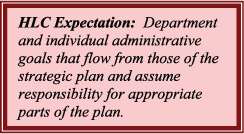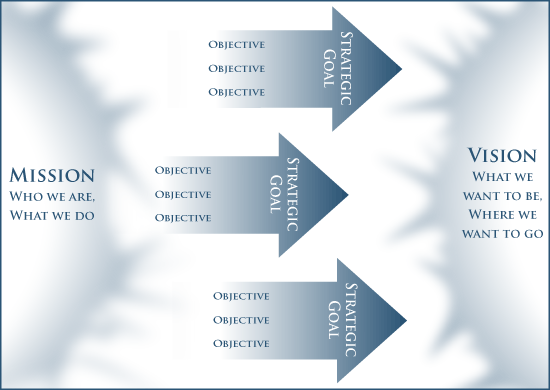

The Mission and Goals
Prior to the comprehensive visit, the mission had last been revised in 1998, about the same time the College adopted a statement of shared values. After the 2002 comprehensive visit, the mission was reconsidered and revised.
A major portion of the January 2004 in-service was devoted to mission, goals and strategic planning. Staff were introduced to these concepts to develop a common understanding and were then divided into groups and assigned tasks related to generating a mission and objectives for a strategic plan. Initial progress was satisfactory but the tasks were not completed. Following the in-service, an ad hoc task force formed with the purpose of completing the mission statement. The mission statement that resulted was presented to the Board of Trustees at its March 22, 2004, meeting and reads as follows:

Not only was the College satisfied with the new mission statement, the mission was in alignment with that of the Illinois Community College System, which reads as follows:
To administer the PublicCommunity College Act in a manner that maximizes the ability of the community colleges to serve their communities.
To promote cooperation within the system and accommodate those State of Illinois initiatives that are appropriate for community colleges.
To be accountable to the students, employers, lawmakers, and taxpayers of Illinois.
To provide high-quality, accessible, cost-effective educational opportunities for the individuals and communities they serve.
Additionally, the SVCC mission statement was also aligned with
the Illinois Community College Board's strategic plan, Promise
for Illinois.†![]()
![]()

As the SVCC mission statement was finalized, another ad hoc task force formed to continue the work started at the in-service and to complete the objectives, which were subsequently adopted by the College. The strategic goals and objectives are as follows:
1. We will provide quality education for students.
- Maintain academic integrity and standards while addressing student needs.
- Offer educational programs that are responsive to the district’s needs.
- Measure student learning through an ongoing program of academic assessment.
- Employ qualified, dedicated, and skilled faculty and staff.
- Maintain appropriate technologies and facilities to support quality instruction.
- Offer a variety of educational delivery systems to maximize student access to learning.
- Continuously review and enhance class schedules and curricula to best meet student needs.
- Deliver well integrated curricular and advising experiences for students.
- Provide effective learning support for different student populations, including first-generation and adult learners.
- Monitor institutional effectiveness through assessment of progress and other indicators.
2. We will be fiscally responsible.
- Broaden the financial base of the institution.
- Employ an integrated system of strategic, operational, financial, capital, technology, facilities, and marketing plans.
- Strive to maintain a balance between educational quality and cost containment.
- Maintain appropriate technologies to support effective administration.
- Secure targeted external funding to support and enhance the teaching and learning environment.
- Continuously seek ways to upgrade and streamline organizational functions and services.
- Manage College resources in a fiscally responsible manner.
3. We will represent SVCC positively.
- Encourage student engagement and retention through a caring faculty and staff and programmatic excellence.
- Strive to create an increasingly inclusive learning and work environment.
- Promote a sense of teamwork across all areas of the College.
- Sponsor lively and meaningful co-curricular programs to enrich students overall educational experience.
- Network with professional organizations, legislators, and governing boards at the local, state, and federal levels to strengthen institutional effectiveness, assure adequate resources, and encourage degree-related articulation.
- Develop and execute effective marketing strategies tailored to program needs.
- Achieve high visibility of the College’s educational programs and services through community engagement and effective marketing.
4. We will respect all SVCC stakeholders.
- Provide a welcoming, supportive, and challenging environment for students.
- Offer quality professional development opportunities for faculty and staff.
- Facilitate teamwork among educational institutions within the community.
- Maintain strong relationships with business, industry, educational, and civic/nonprofit groups to best serve the educational needs of each sector.
- Train and support faculty, administrators, and staff in the use of current technologies.
- Recognize and celebrate efforts and successes of College employees.
- Offer broad opportunities for informed participation by all members of the College community in shaping College policies, practices, and directions.

- Communicate clearly and effectively among College constituents.
- Develop a quality understanding and practice of shared values among administrators, faculty, staff and students.
- Encourage good health, wellness, and safety practices among employees and students.

During the summer of 2004, the College described the relationship among the various elements of strategic planning to clarify their meanings and illustrate their importance. The mission was defined as the description of where the College is and what it does; the vision as being future oriented, describing where the College wants to be; and the strategic goals as the broad steps needed to move from the mission to attain the vision. To clarify the relationship among the mission, the strategic goals and objectives relate to strategic planning
The following illustration was developed to show these relationships:
This diagram indicates the importance of a College vision statement. The Board of Trustees has assumed the responsibility of determining the vision statement and has scheduled a special planning retreat in January 2006, where it plans to articulate the College's vision statement.







